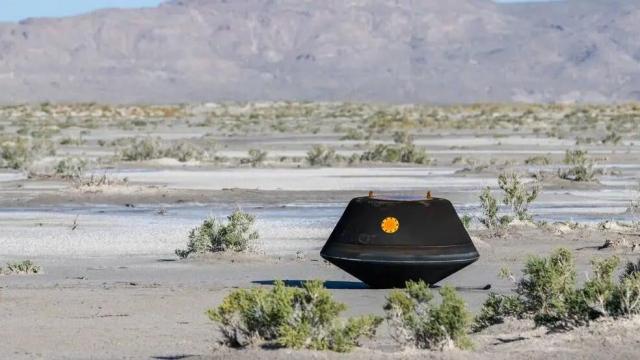Inconsistent labels in the OSIRIS-REx landing plans are what caused the out-of-order parachute deployment during the return capsule’s descent to Earth on September 24, NASA stated in a release yesterday.
OSIRIS-REx carried samples of the asteroid Bennu to Earth in late September—an “astrobiologist’s dream,” as Gizmodo previously reported. Bennu is a relic of the solar system’s formation, so scrutiny of its composition will offer hints at the primordial ingredients of life, but also the components of our early solar system. The sample canister from the asteroid contains a greater quantity of asteroid fragments than anticipated, which is a boon to scientists. However, these extra materials were discovered on the canister’s outside; recovery teams are facing difficulties in opening the canister, which contains the bulk of the samples.
The sample return was parachuted down to Earth—specifically alighted on the desert in Utah—on September 24, and since then, NASA’s been carefully working to get the canister opened.
The return capsule landed safely on Earth in spite of the design flaw, but the space agency (naturally) wanted to get to the bottom of the hiccup to ensure it doesn’t happen again. Video review of the descent and scrutiny of the system’s design plans indicated that the affected drogue parachute fired out of order due to the wiring of the capsules’ parachute triggers.
The drogue was supposed to deploy, slowing the capsule’s descent to the surface when it reached an altitude of roughly 10,000 feet (3 kilometers). Instead, when the capsule was at 100,000 feet (30 km), the drogue’s retention cord was cut, separating it from the capsule while still in its packaging. Then, when the capsule reached about 9,000 feet (2.7 km), the drogue was deployed—separating it entirely from the rest of the system. According to the NASA release, the capsule still arrived safely on the ground thanks to the strength of the main parachute.
NASA found the issue in the OSIRIS-REx design plans, specifically in the liberal use of the word “main.” In the designs for the device that sends electrical signals, “main” referred to the main chute, but on the receiver side of the design “main” referred to a pyrotechnic device that deployed the drogue chute. “Engineers connected the two mains, causing the parachute deployment actions to occur out of order,” the NASA release stated.
The agency’s conclusions about the parachute hiccup could be confirmed by testing the system that releases the parachutes, which is sitting in one of the glove boxes that houses the Bennu sample at the Johnson Space Center in Houston. The sample materials will need to be processed first—a thorough, albeit slow-going task—but then engineers can dive into the hardware, to ensure that such a blooper doesn’t happen again.
